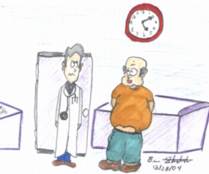Physicians'
Reactions to Patient Size
  
Research conducted by: Mikki
Hebl and Jingping Xu
Case study prepared by: Emily
Zitek
Overview
Obese people face discrimination
on a daily basis in employment, education, and relationship contexts.
Past research has shown that even doctors, who are trained to treat
all their patients warmly and have access to literature suggesting
uncontrollable and hereditary aspects of obesity, believe obese individuals
are undisciplined and suffer from controllability issues. This case
study examines how doctors treat overweight as compared to normal
weight patients.
Various doctors at one of three major hospitals in the Texas Medical
Center of Houston participated in the study. These doctors were
sent a packet containing a medical chart similar to the one they
view upon seeing a patient. This chart portrayed a patient who was
displaying symptoms of a migraine headache but was otherwise healthy.
This chart also contained a measure of the patient's weight. Doctors
were randomly assigned to receive the chart of a patient who was
overweight or the chart of a patient who was of normal weight. After
reviewing the chart, the doctors then had to indicate how much time
they believed they would spend with the patient.
Questions to Answer
Do doctors
discriminate against overweight patients? Specifically, do the doctors
who review charts of overweight patients say they would spend the
same amount of time with their patients as the doctors who review
charts of normal weight patients?
Design Issues
The method and
data described here are only a small part of a larger study. See the
reference below for a full description of the study.
Descriptions of Variables
| Variable |
Description |
| Patient weight |
1 = average weight, 2 = overweight |
| Time |
represents how long the doctors said they would spend with
the patient |
| References |
|
Hebl, M., & Xu, J., "Weighing
the care: Physicians' reactions to the size of a patient,"
International Journal of Obesity, 25 (2001): 1246-1252
|
Links
The
Rudd Institute
| Exercises |
- Create box plots comparing the time expected to be spent
with the average-weight and overweight patients.
- What is the mean expected time spent for the average-
weight patients? What is the mean expected time spent for
the overweight patients?
- What is the difference in means between the groups? Approximately
how many standard deviations do the means differ?
- Plot histograms of the time spent with the average-weight
and overweight patients.
- To which group does the patient with the highest expected
time belong?
- Perform an independent samples t test comparing the time
spent with the average-weight patients as compared to the
time spent with the overweight patients. Is this difference
statistically significant?
- What is the confidence interval on the difference between
mean time spent with each group?
|
|
|